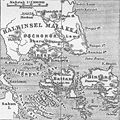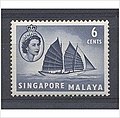Portal:Singapore
 Map of Singapore Singapore, officially the Republic of Singapore, is an island country and city-state in Southeast Asia. The country's territory comprises one main island, 63 satellite islands and islets, and one outlying islet. It is about one degree of latitude (137 kilometres or 85 miles) north of the equator, off the southern tip of the Malay Peninsula, bordering the Strait of Malacca to the west, the Singapore Strait to the south along with the Riau Islands in Indonesia, the South China Sea to the east, and the Straits of Johor along with the State of Johor in Malaysia to the north.
In its early history, Singapore was a maritime emporium known as Temasek and subsequently a major constituent part of several successive thalassocratic empires. Its contemporary era began in 1819, when Stamford Raffles established Singapore as an entrepôt trading post of the British Empire. In 1867, Singapore came under the direct control of Britain as part of the Straits Settlements. During World War II, Singapore was occupied by Japan in 1942 and returned to British control as a Crown colony following Japan's surrender in 1945. Singapore gained self-governance in 1959 and, in 1963, became part of the new federation of Malaysia, alongside Malaya, North Borneo, and Sarawak. Ideological differences led to Singapore's expulsion from the federation two years later; Singapore became an independent sovereign country in 1965. After early years of turbulence and despite lacking natural resources and a hinterland, the nation rapidly developed to become one of the Four Asian Tigers. As a highly developed country, it has one of the highest PPP-adjusted GDP per capita. It is also identified as a tax haven. Singapore is the only country in Asia with a AAA sovereign credit rating from all major rating agencies. It is a major aviation, financial, and maritime shipping hub and has consistently been ranked as one of the most expensive cities to live in for expatriates and foreign workers. Singapore ranks highly in key social indicators: education, healthcare, quality of life, personal safety, infrastructure, and housing, with a home-ownership rate of 88 percent. Singaporeans enjoy one of the longest life expectancies, fastest Internet connection speeds, lowest infant mortality rates, and lowest levels of corruption in the world. It has the third highest population density of any country, although there are numerous green and recreational spaces as a result of urban planning. With a multicultural population and in recognition of the cultural identities of the major ethnic groups within the nation, Singapore has four official languages: English, Malay, Mandarin, and Tamil. English is the common language, with exclusive use in numerous public services. Multi-racialism is enshrined in the constitution and continues to shape national policies. Singapore is a parliamentary republic and its legal system is based on common law. While the country is de jure a multi-party democracy with free elections, the government under the People's Action Party (PAP) wields widespread control and political dominance. One of the five founding members of ASEAN, Singapore is also the headquarters of the Asia-Pacific Economic Cooperation Secretariat, the Pacific Economic Cooperation Council Secretariat, and is the host city of many international conferences and events. Singapore is also a member of the United Nations, the World Trade Organization, the East Asia Summit, the Non-Aligned Movement, and the Commonwealth of Nations. (Full article...)Selected article -Pathlight School is a special school for children with autism in Singapore. Founded in 2004, it is run by the non-profit Autism Resource Centre and comprises one half of the national educational provision for autistic children. The school educates students in social and life skills, teaches them mainstream curriculum subjects and prepares them for employment in an autism friendly environment. (Full article...) Selected picture Resorts World Sentosa, one of the two Integrated Resorts in Singapore. This view is from the Tiger Sky Tower. Read more... General imagesThe following are images from various Singapore-related articles on Wikipedia.
Selected biography -Han Sai Por (Chinese: 韓少芙; born 19 July 1943) is a Singaporean sculptor. A graduate of the Nanyang Academy of Fine Arts (NAFA), East Ham College of Art, Wolverhampton College of Art (now the School of Art and Design of the University of Wolverhampton), and Lincoln University, New Zealand, she worked as a teacher and later as a part-time lecturer at NAFA, the LASALLE-SIA College of the Arts, and the National Institute of Education, Nanyang Technological University, before becoming a full-time artist in 1997. Han has participated in exhibitions locally and abroad, including events in China, Denmark, Japan, Malaysia, New Zealand, and South Korea. Her first solo exhibition, entitled Four Dimensions, was held at the National Museum Art Gallery in 1993. Her sculptures can be found around the world, in Osaka and Shōdoshima, Kagawa Prefecture, in Japan; Kuala Lumpur and Sarawak in Malaysia; and Washington, D.C., in Singapore, sculptures commissioned from her can be seen at Capital Tower, the Defence Science Organisation National Laboratories, the Esplanade – Theatres on the Bay, the National Museum of Singapore, Revenue House, Singapore Changi Airport Terminal 3, Suntec City Mall, and Woodlands Regional Library. In 2001, Han was the founding President of the Sculpture Society (Singapore) and remains its Honorary President. She was the first artist in residence at the Society's Sculpture Pavilion at Fort Canning Park in 2009, where she worked on sculptures made from the trunks of tembusu trees. (Full article...) Did you know (auto-generated)
In this month
More did you know -
Selected panoramaA panoramic view of the roads and harbour in Singapore in the 1870s Singapore topicsRelated portalsSoutheast Asia Other Countries Tasks
CategoriesWikiprojectsAssociated WikimediaThe following Wikimedia Foundation sister projects provide more on this subject:
Discover Wikipedia using portals |
































































